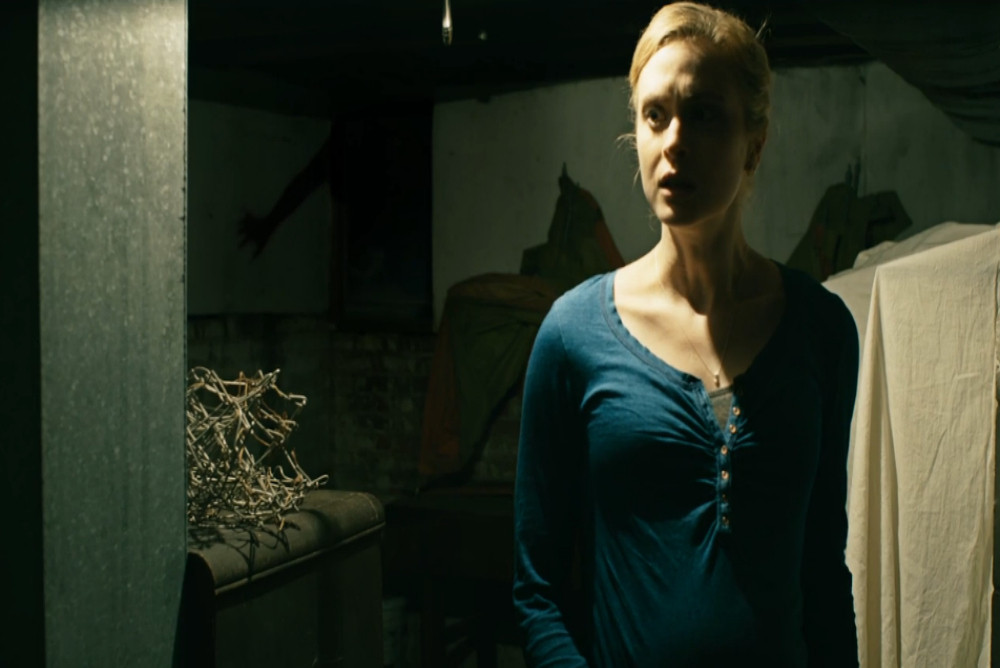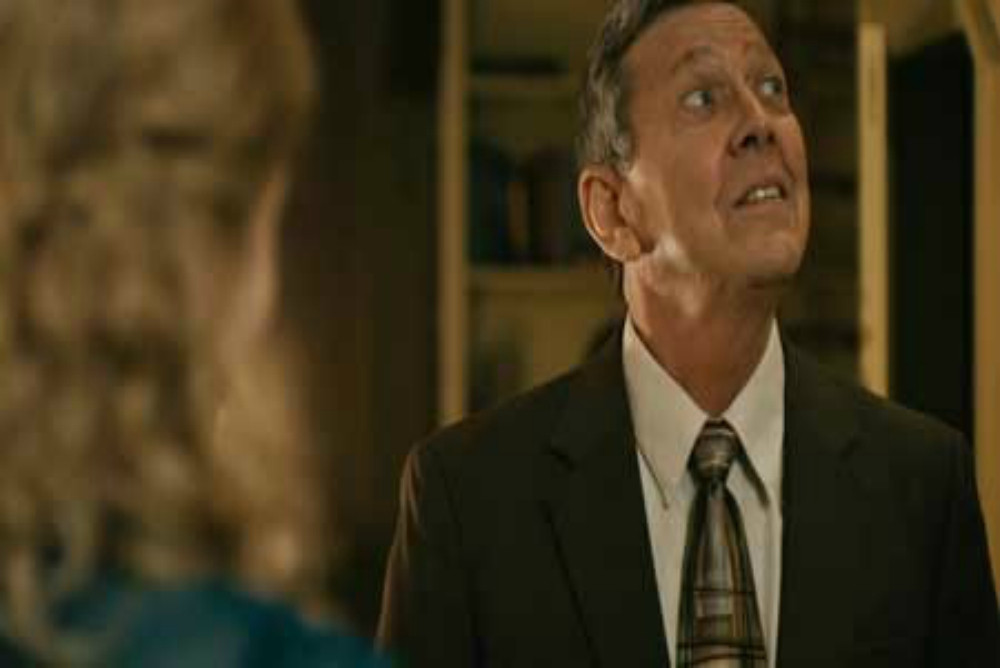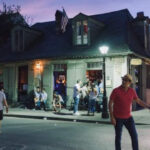The House on Pine Street emerges as a standout in the independent horror scene of 2015, securing a place among the top tier alongside Karyn Kusama’s The Invitation and Perry Blackshear’s They Look Like People. This film exemplifies the raw creativity and grassroots spirit often found in Street Movies, proving that impactful horror can thrive outside of mainstream studio productions.
Synopsis: Domestic Unease and Paranormal Intrusion
The narrative centers on Jenny (Emily Goss) and Luke (Taylor Bottles), a young couple relocating from the urban landscape of Chicago to Jenny’s quieter hometown in Kansas. Seven months into her pregnancy, Jenny is portrayed as fragile, recovering from a mental breakdown linked to her condition, according to her husband and overbearing mother, Meredith (Cathy Barnett). Her unhappiness is palpable – a discomfort with returning to Kansas, being near her mother, leaving her Chicago life behind, and facing impending motherhood. This unease soon escalates as unsettling events begin to plague their new residence on Pine Street.
The House on Pine Street is a testament to independent filmmaking, crafted by Natalie Jones in collaboration with directors Austin and Aaron Keeling. This team, comprising University of Kansas and University of Southern California graduates, all under twenty-four during production, embodies the DIY ethos of street movies. Mirroring the low-budget, immersive filmmaking style reminiscent of George Romero’s Night of the Living Dead, the cast and crew lived within the very “haunted” house used for filming during the nineteen-day shoot.
Classic Horror Echoes with a Modern Indie Edge
What sets The House on Pine Street apart is its masterful weaving of classic supernatural horror tropes with a distinctly independent film sensibility. The film subtly nods to literary predecessors without becoming derivative. Two key works come to mind: Charlotte Perkins Gilman’s “The Yellow Wallpaper” (1892) and Shirley Jackson’s The Haunting of Hill House (1959). Superficial parallels exist – Gilman’s narrator’s sister-in-law is named Jennie, and the Pine Street nursery is painted yellow. Character names also resonate with Jackson’s novel: Walter Vance, the film’s medium, shares a surname with Eleanor Vance from The Haunting of Hill House, and Jenny’s husband is named Luke, mirroring a main character in Jackson’s work.
Alt text: Jennifer, the pregnant protagonist of the street movie “The House on Pine Street”, looking distressed in a dimly lit room, hinting at psychological horror.
However, the film’s deeper connection to Gilman and Jackson lies in its adept navigation of the blurred line between the supernatural and the psychological. Throughout much of the movie, ambiguity prevails: are the strange occurrences genuinely paranormal, or are they manifestations of Jenny’s profound unhappiness, rooted in her pregnancy? Are the “ghosts” independent entities, or projections of her inner turmoil? Jenny herself vocalizes this central question, echoing Eleanor Vance’s anxieties: “It’s the house. It’s in my head.” But the film cleverly leaves us questioning: Is it only in her head? And what are the implications if it is? Is she simply imagining things, or has the house itself infiltrated her psyche?
This very question forms the core of Gilman’s and Jackson’s narratives, each also centered on profoundly troubled female protagonists. Furthermore, in all three works, the protagonists’ struggles are intertwined with themes of femininity and motherhood – the complexities of being a mother, having a mother, and the intricate dynamics of mother-daughter relationships. The House on Pine Street also evokes Rosemary’s Baby (Roman Polanski, 1968), in its exploration of a pregnant woman’s perceived loss of control over her own body. The film subtly portrays Jenny’s mother and husband, often framed together, suggesting a silent conspiracy, prioritizing the unborn child over Jenny’s well-being. This perceived lack of autonomy, the disregard for her desires and needs, fuels Jenny’s internal rebellion and arguably becomes the true source of horror within the film. This resonates deeply with contemporary anxieties, making it a relevant piece of street movie that speaks to current audiences.
Alt text: A tense dinner scene from the indie street movie “The House on Pine Street”, featuring Jennifer, her husband Luke, and her mother Meredith, highlighting family dynamics and underlying tension.
Understated Scares and Psychological Tension
Beyond its clever intertextuality and feminist undercurrents, The House on Pine Street succeeds as a genuinely frightening film. It’s the kind of horror that heightens your awareness of everyday sounds and makes shadows seem menacing. The scares are subtle, hinting at horrors rather than explicitly showing them. Crucially, many unsettling moments stem not from overt supernatural events, but from Jenny’s interactions with those around her. Unfamiliar faces stare with unsettling intensity, fueling the ambiguity surrounding her sanity and questioning whether her perception of reality is skewed by paranoia. This nuanced approach is a hallmark of effective street movies that rely on atmosphere and psychological depth over jump scares.
Alt text: Close-up shot from the street movie “The House on Pine Street” emphasizing Jennifer’s hand and worried expression, symbolizing her vulnerability and psychological distress.
The Medium’s Message: Less is More in Street Horror
A minor critique lies in the character of Walter Vance (Jim Korinke), the medium. His explications feel somewhat heavy-handed, slowing the film’s momentum. Walter’s intended purpose, seemingly, is to directly state the inherent inexplicability of the paranormal. He declares, “the very definition of paranormal is that which cannot be explained,” existing “outside of our understanding, our world. It’s the unknown. That’s why it’s so terrifying.” While this explanation is arguably acceptable, the film had already effectively demonstrated this concept through its narrative, rendering the verbal explanation somewhat redundant. Walter’s subsequent return later in the film, offering further exposition, feels particularly unnecessary. He attempts to clarify an ambiguity that the narrative itself has already masterfully revealed. In street movies, often the power lies in showing, not telling, and trusting the audience to piece together the unease.
Alt text: Walter Vance, the medium character in the independent street movie “The House on Pine Street”, in a scene where his exposition arguably detracts from the film’s subtlety.
Walter’s late-film explanations also delay the final scenes, which are, in fact, perfectly intriguing and provide a fitting conclusion. They sustain the film’s central ambiguity: To what extent are events driven by external supernatural forces, and to what extent are they manifestations of Jenny’s own psyche? The film purposefully leaves this question unanswered, a strength that resonates with the best street horror, leaving a lasting sense of unease and prompting reflection long after the credits roll.
111 mins | Aaron and Austin Keeling | (USA) | 2015
Grade: A-
The House on Pine Street is available on DVD and streaming platforms, offering a chance to experience this compelling example of independent, street-level horror.
ArchiveReviewsThe House on Pine Street


 2. hops dinner
2. hops dinner 3. HOPS3 Jennifer and hand
3. HOPS3 Jennifer and hand 4. HOPS Walter
4. HOPS Walter